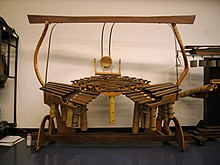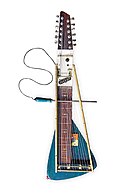Microtonalism

In the field of music, microtonalism or xenharmonics is music that uses microtones (musical intervals smaller than a semitone). In traditional Western music, an octave is divided into 12 equal semitones. In microtonalism more notes are used, generally the system of 15, 17, 19, 22, 31, 41 and 53 notes per octave is used. The American musician Charles Ives humorously defined microtones as “the notes between the keys of the piano.”
Many contemporary theorists try to organize the division of microtones in such a way that they can be related melodically and harmonically just like the tones used in the twelve-tone system. According to some composers, the microtone would open new doors and horizons in the world of contemporary music.
History
The current view about microtonalism is that it has existed since ancient times in non-Western music (Indian, Arabic), in Greek music (enharmonic system), in medieval music (although this statement is subject to controversy), and in the folk music of some European regions, although more as an accident or theory than as a conscious practice.
Among the most remote antecedents that are now known, Nicolà Vicentino and Vicente Lusitano are mentioned, who at the beginning of the baroque period (century XVI) debated about reviving the Greek chromatic and enharmonic system (based on a division of the scale into 31 parts, and not into 12 parts, as in the current tonal system).
In the 17th century Christian Huygens proposed the division of the octave into 31 equal parts (Greek system). The canon and physicist William Holder proposed dividing it into 53 sounds. Chevé proposed a scale of 50 sounds. These systems intended a musical temperament closer to acoustic theory, however these systems were put into practice without much success like the current theories of microtonalism since we continue to use the tempered system of 12 equidistant sounds per octave in all music schools. academic.
One of the last authors in history to put microtonalism into practice without academic success, based on an unused theory that can write microtonalism in intervals of 16ths, 32nds, 64ths and even 128ths of tone, was Julián Carrillo who In his 1895 experiment he opted for the 16ths of tone, increasing to 96 sounds per octave. Currently, his theory is already 100 years old since it was formulated and it has not had the success of the temperament of 12, much less academic interest in schools and conservatories. who generally consider it a failure. Another is Alois Hába who was the creator of the tonal system based on the use of fourth and sixth tones in Western music. From 1924 to 1943 he built special instruments and composed a new microtonal language of great expressive power.
Musicologists
For years, microtonalism and tuning theorists have worked and presented their research, and although most contemporary music continues to use a tempered system of 12 notes per octave, there are many alternative tonal scales, more or less less refined, from those based on prime numbers, those based on Fibonacci numbers to theories based on physics and mathematics.
Microtonal musicians
On a theoretical and practical level, with many experimental compositions musicians are mentioned:
- Richard Heinrich Stein (Germany, 1882-1942), who built a small piano and a clarinet for tone rooms and composed two pieces for cello and piano in tone rooms (1906).
- Willi von Moellendorf (Germany): He built a small arch of tone rooms and composed a few pieces in tone rooms.
- Joerg Mager (Germany) composed some studies in tone rooms.
- Alois Hába (Checoslovaco): (Vizovice, 1893-Praga, 1973) Czechoslovak music composer and theorist. Advocate of microtonalism, built special instruments and composed according to the rules laid down in his work New harmonic rules of the diatonic and chromatic system on third, fourth, sixth and twelfth tone (1927).
- Ivan A. Wyschnegradsky (Russia, 1893–1979): In 1932 he published a book entitled Manuel d ́harmonie à quarts de ton. He built a piano in tone rooms that had three keyboards.
- Ferruccio Busoni (Italy): he did some unsuccessful experiments in the adaptation of a third tone piano, and in order not to compromise the tone media he proposed a double series of thirds of tone (i.e., sixth tone).
- Hans Barth, who composed a Concert for piano in tone rooms and strings (1930).
- Julián Carrillo (Mexico 1875-1965) He built 16 pianos, harps, flautas, guitars and cellos capable of generating rooms, eighths and even 16th-century tone. He recorded in Paris works in quarters and eighths of tone, offered concerts in New York, Philadelphia, Paris and Mexico as well as developing the Theory of Sound 13.
- Gérard Grisey: along with Tristan Murail founded the French spectral movement, which was characterized by the generation of verticalities that derive from intervals of the natural harmonic spectrum of sound, which contains microtonal heights that are ever closer from the tenth harmonic onwards.
- Valeri Brainin (1948), 29-scale.
- Francisco Guerrero (Spain 1951-1997), perhaps the most important Spanish composer of the second half of the centuryXX., worked with systems in which the abundance of microtonal heights derives from complex mathematical formulas and fractal conceptions of sound gestures.
- Armando Nava Loya (Mexico 1957) Difusor of the musical theory called Sonido 13 with the musical instrument called "Arpa Microinterválica", the only instrument in the world capable of producing 909 sounds in nine octave calls.
- Miguel Oblitas Bustamante (Nasca, Peru 1964): in his symphony "Las Pampas de Nasca" (1984), written for soloist singers, Coro, Antaras de ceramic, Banda militar y Orquesta Sinfónica, employs microtonos of the antaras of the Nasca culture.
- Javier Torres Maldonado (Mexico 1968) has resumed some of the ideas proposed by Grisey, taking them, in some of his works, at moments of consonance and spectral dissonance that depend on the overlap of fragments of spectrums built on different fundamentals, as well as other systems that surpass the spectral origin of these concepts, such as the inarmonic contraction or different combination techniques of smaller intervals than the semitone.
- Trey Spruance (California 1969).
- Walter Mack (Argentina 1975) based on mathematical formulas created scales for multiple microtonal systems and an instrument in a system of thirds of tones, and an instrument that combines 12 with 18 notes.
- Charles Antonio Loli Antequera (Peru 1975): based on mathematical inductions, series of harmonics and the eighth pythagorean, summarised scales in relation to harmony for microtonal systems of divisions in equal parts of the eighth with approximations to the fifth of harmonics and his writing in the "Pentadecagram" (system of 15 parallel lines in groups of 5 for a tonal scale of 17notes). He put microtonal systems into practice using music software. He currently develops a program called Tonalismo(www.tonalismo.com) based on his theory for microtonal instruments with tunings close to the harmonic series, such as 17edo, 29edo, 41edo, 53edo...etc. www.microtonalismo.com
- King Gizzard " the Lizard Wizard (Australia, 2017) Band of psychedelic rock that began to explore in this sound with a collection of 5 albums.
- Soust (Bolivia, 2019) Progressive rock soloist project, experimental music and art rock by Issa Montano, who employs a modified guitar in microtonalities for the song "Samara In Babel" of his album Atonement Eleutheria.
Microtonal instruments

Some electroacoustic instruments from the 1920s that came out of the 12-sound temperament served as an impetus for the emergence of microtonal instruments. Some examples of microtonal instruments are:
- The Martenot waves (used later by Olivier Messiaen and Ivan Wischnegradsky, among others),
- The trautonium (used by Paul Hindemith),
- The ondoline,
- The theremin,
- The Moodswinger of Yuri Landman,
- The Microinterval Arpa, invented by Mexican Oscar Vargas Leal, the only instrument in the world capable of producing 909 sounds in nine octave calls,
- The dinarra, a dynamic microtonal guitar, invented by the Uruguayan Eduardo Sábat-Garibaldi,
- The tetarra, microtonal guitar invented by Ecuadorian Lucho Enríquez.
- The trombone
- The Flaut
All stringed instruments that are not divided by frets are capable of playing microtonal notes.
Experimental music
Some musicians used the new intervals as a casual enrichment of the composition rather than as new musical systems, such as the Romanian George Enescu (1881-1955) and the Hungarian Bela Bártok (1881-1945). But the interest was so present that in 1922 Alois Hába attended an International Congress of Quarter-Tone Composers and the following year he taught quarter-tone classes at the Prague Conservatory. Julián Carrillo publishes his Microtonal Theory called "Sonido 13" in New York around the year 1916. Later he recorded several compositions in Fourths, Eighths and Sixteenths of Tone in Paris, after several concerts held since 1925. In Peru, the composer from Nasca Miguel Oblitas Bustamante (1964), has used microtones in his Symphony "Las Pampas de Nasca" (1984), written for solo singers, Choir, Ceramic Antaras, Military Band and Symphony Orchestra.
Theory
At the beginning of the 20th century, musicians began to study the possibility of expanding the richness of the twelve-sound temperament by employing thirds and quarters of tone, and this same interest led them to study Indian, Arabic, Slovak, Romanian, and Hungarian music, as well as to study those theorists of the past to integrate the new intervals into Western music. Evidently the interest of the musicians of the XX century and those of previous centuries was different:
- In ancient times, the intervals emerged as a reflection of a diatonic system transported at various heights, or of the 53 commas of Pythagoras.
- In the centuryXX. the intervals arose from the intentional division of the octave not into 12 semitones, but in 18 thirds of tone, or 24 quarters of tone (even a few years later it was urged to divide the scale into 17, 19, 20, 22, 27 or any number of parts called microtonos).
The search was arduous, since the new intervals required several factors:
- A different notation.
- Tempered instruments (such as piano or guitar) that produce them and serve as a guide to the untempered (such as violins and celloles) for the exact tuning.
- New rules of harmony and counterpoint.
- The revision of the theoretical foundations of the system of twelve sounds.
The musicians who dealt with the matter were many, some were satisfied with theoretical speculations, others with a few exercises on instruments adapted for that purpose, and a few took their attempts to the limit by building new instruments, creating a new musical theory to microintervals, composing a good number of works and presenting them in concerts.
Microtonal and macrotonal scales
Old
Some traditional scales that do not use 12 semitones per octave:
- Traditional Javanese scale, 5 tones.
- Traditional siamese scale, 7 tones.
- Raga Shruti, 22 tones (India).
- Traditional Thai scale, 8 tones.
- Nasca Scale researched by Miguel Oblitas Bustamante.
- Lu, 12 notes (in the Han Era, China).
- 17-ton Persian Scale.
- Iraq Enarmonic scale of 8 tones.
Contemporary
These are some of the scales developed by important theorists or musicians:
- Bohlen-Pierce Scale of 13 tones
- Alpha, Beta and Gamma Scales by Wendy Carlos
- Kimberger I, Kimberger II and Kimberger III (Johann Philipp Kirnberger), who are historically mesotronic relatives.
- Euler Genos System or Euler-Fokker Generation / Octony Scale (Leonhard Euler).
- 9-tone modal scale (Max Méreaux).
- 29 tones scale (Valeri Brainin).
- 43 tones scale (Harry Partch).
- Ervin M. Wilson Scales:
- Hexany, 6 tones.
- Eikosany, 20 tones.
- Dekatesserany, 14 tones.
- 53 tones scale (Larry Hanson).
- 96 tones scale, "Sound 13" (Julián Carrillo).
- 19-tone scale (Joseph Yasser).
- Scale of 23 tones (Yuri Landman, Moodswinger).
- Scales close to fifth multiples of 12, 17, 19, 29, 31, 41, 53, theoretical proposal of - "Inductive microtonal harmony alfa edo" (Charles Loli).
Contenido relacionado
Hildegard of Bingen
Richard Z. Kruspe
Maksim Venguerov
Alex Lora
Haas curve